
The amphisbaena is a mythological, ant-eating serpent with a head at each end. The creature is alternatively called the amphisbaina, amphisbene, amphisboena, amphisbona, amphista, amfivena, amphivena, or anphivena, and is also known as the "Mother of Ants". Its name comes from the Greek words amphis, meaning "both ways", and bainein, meaning "to go".

The chupacabra or chupacabras is a legendary creature, or cryptid, in the folklore of parts of the Americas. The name comes from the animal's reported vampirism—the chupacabra is said to attack and drink the blood of livestock, including goats.

A dragon is a magical legendary creature that appears in the folklore of multiple cultures worldwide. Beliefs about dragons vary considerably through regions, but dragons in Western cultures since the High Middle Ages have often been depicted as winged, horned, and capable of breathing fire. Dragons in eastern cultures are usually depicted as wingless, four-legged, serpentine creatures with above-average intelligence. Commonalities between dragons' traits are often a hybridization of feline, reptilian, mammalian, and avian features. Some scholars believe large extinct or migrating crocodiles bear the closest resemblance, especially when encountered in forested or swampy areas, and are most likely the template of modern Asian dragon imagery.

Snakes are elongated, limbless, carnivorous reptiles of the suborder Serpentes. Like all other squamates, snakes are ectothermic, amniote vertebrates covered in overlapping scales. Many species of snakes have skulls with several more joints than their lizard ancestors, enabling them to swallow prey much larger than their heads. To accommodate their narrow bodies, snakes' paired organs appear one in front of the other instead of side by side, and most have only one functional lung. Some species retain a pelvic girdle with a pair of vestigial claws on either side of the cloaca. Lizards have independently evolved elongate bodies without limbs or with greatly reduced limbs at least twenty-five times via convergent evolution, leading to many lineages of legless lizards. These resemble snakes, but several common groups of legless lizards have eyelids and external ears, which snakes lack, although this rule is not universal.
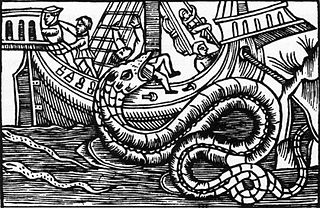
A sea serpent is a type of sea monster described in various mythologies, most notably in Mesopotamian cosmology (Tiamat), Ugaritic cosmology biblical cosmology, Greek cosmology, and Norse cosmology (Jörmungandr).

The European dragon is a legendary creature in folklore and mythology among the overlapping cultures of Europe.

Ayida-Weddo, also known as Ayida, Ayida-Wedo, Aido Quedo, Aido Wedo, Aida Wedo, and Aido Hwedo, is a powerful loa spirit in Vodou, revered in regions across Africa and the Caribbean, namely in Benin and Haiti. Known as the "Rainbow Serpent", Ayida-Weddo is the loa of fertility, rainbows, wind, water, fire, wealth, thunder, and snakes. Alongside Damballa, Ayida-Weddo is regarded among the most ancient and significant loa. Considered in many sources as the female half of Damballa's twin spirit, the names Da Ayida Hwedo, Dan Ayida Hwedo, and Dan Aida Wedo have also been used to refer to her. Thought to have existed before the Earth, Ayida-Weddo assisted the creator goddess Mawu-Lisa in the formation of the world, and is responsible for holding together the Earth and heavens. Ayida-Weddo bestows love and well-being upon her followers, teaching fluidity and the connection between body and spirit.
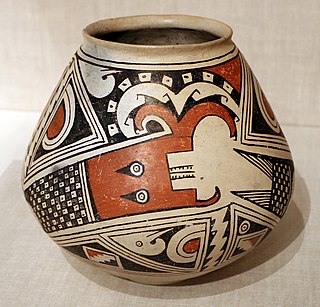
The Horned Serpent appears in the mythologies of many cultures including Native American peoples, European, and Near Eastern mythology. Details vary among cultures, with many of the stories associating the mystical figure with water, rain, lightning, thunder, and rebirth. Horned Serpents were major components of the Southeastern Ceremonial Complex of North American prehistory.

The ouroboros or uroboros is an ancient symbol depicting a serpent or dragon eating its own tail. The ouroboros entered Western tradition via ancient Egyptian iconography and the Greek magical tradition. It was adopted as a symbol in Gnosticism and Hermeticism and most notably in alchemy. Some snakes, such as rat snakes, have been known to consume themselves.

A cockatrice is a mythical beast, essentially a two-legged dragon, wyvern, or serpent-like creature with a rooster's head. Described by Laurence Breiner as "an ornament in the drama and poetry of the Elizabethans", it was featured prominently in English thought and myth for centuries. They are created by a toad or snake's egg hatched by a chicken.

The Rainbow Serpent or Rainbow Snake is a common deity often seen as the creator God, known by numerous names in different Australian Aboriginal languages by the many different Aboriginal peoples. It is a common motif in the art and religion of many Aboriginal Australian peoples. Much like the archetypal mother goddess, the Rainbow Serpent creates land and diversity for the Aboriginal people, but when disturbed can bring great chaos.

Snakes are a common occurrence in myths for a multitude of cultures. The Hopi people of North America viewed snakes as symbols of healing, transformation, and fertility. Snakes in Mexican folk culture tell about the fear of the snake to the pregnant women where the snake attacks the umbilical cord. The Great Goddess often had snakes as her familiars—sometimes twining around her sacred staff, as in ancient Crete—and they were worshipped as guardians of her mysteries of birth and regeneration. Although not entirely a snake, the plumed serpent, Quetzalcoatl, in Mesoamerican culture, particularly Mayan and Aztec, held a multitude of roles as a deity. He was viewed as a twin entity which embodied that of god and man and equally man and serpent, yet was closely associated with fertility. In ancient Aztec mythology, Quetzalcoatl was the son of the fertility earth goddess, Cihuacoatl, and cloud serpent and hunting god, Maxicoat. His roles took the form of everything from bringer of morning winds and bright daylight for healthy crops, to a sea god capable of bringing on great floods. As shown in the images there are images of the sky serpent with its tail in its mouth, it is believed to be a reverence to the sun, for which Quetzalcoatl was also closely linked.
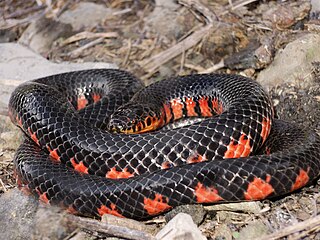
The mud snake is a species of nonvenomous, semiaquatic, colubrid snake endemic to the southeastern United States.
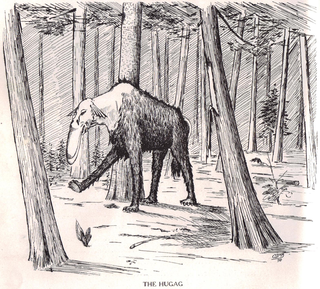
In North American folklore and American mythology fearsome critters were tall tale animals jokingly said to inhabit the wilderness in or around logging camps, especially in the Great Lakes region. Today, the term may also be applied to similar fabulous beasts.

The Grootslang or Grote Slang is a legendary creature that is reputed to dwell in a deep cave in the Richtersveld, South Africa.
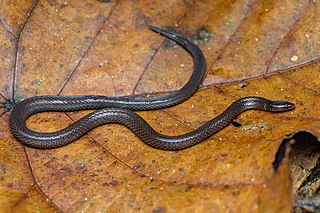
Pseudorabdion longiceps, the dwarf reed snake or Cantor's dwarf reed snake, is a species of snake in the family Colubridae. The species is found in Indonesia, Malaysia, Brunei, Singapore, Thailand, and the Philippines.















